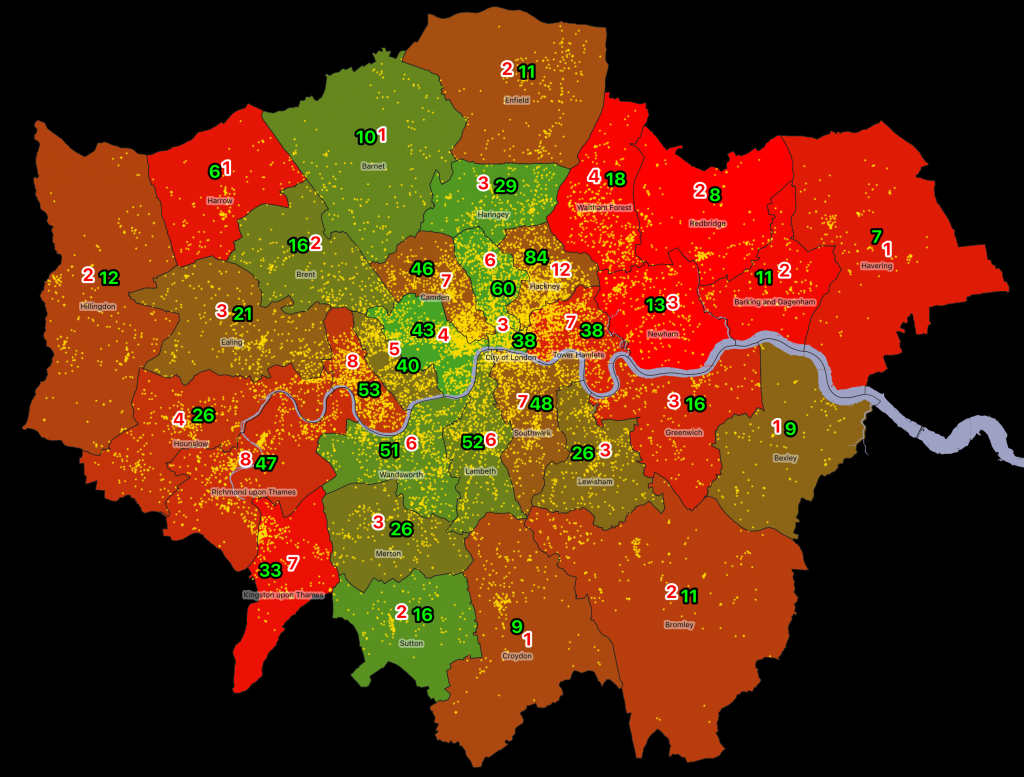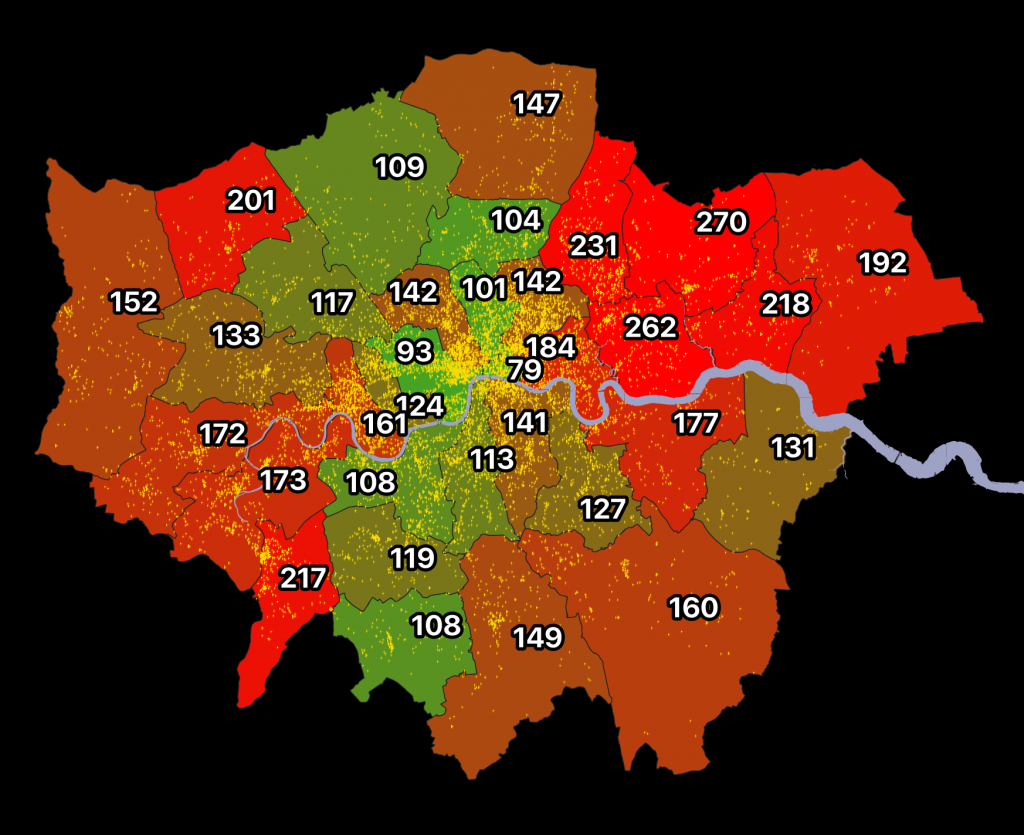This is a draft piece of commentary and I will evolve it in response to any feedback and further analysis I am performing.
A bylaw is being drafted between the 32 London borough councils (and the City of London) to introduce a coordinated approach to managing dockless micromobility sharing, such as bikeshare and (should future national legislation permit it) escootershare, across London.
Currently, each council sets its own policy with regards to dockless cycle operators in their area, making running a pan-London system painful for operators, and resulting in a number of inconsistencies. The matter is further complicated by the parking of a bicycle on a pavement not actually being illegal currently, as long as it is not obstructive, and by “red route” roads in London – the larger roads, which are generally managed by Transport for London and not the councils – and which in some cases have good segregated cycle lanes installed by the transport authority which is more focused on getting people travelling efficiently throughout London, rather than entirely within small borough boundaries – some councils tend not to consider than someone would ever want to leave the borough, as evidenced by mandating max/minimum bike numbers on operators who then watch as their users head, like everyone else, in the direction of the City/Westminster/Canary Wharf, in the morning.
At the same time, there are currently 7 operators in central London (3 free-floating, 2 hub-based and 2 dock-based), a mix of bike types (3 electric systems and 4 manual ones) and yet, while some areas have 5 operators, a third of boroughs have none.
The bylaw will ask each council to outline its policy of where parking of dockless bicycles is allowed, the policy then applied consistently to all operators who want to be in that borough. This potentially could result in huge variations – some, like Islington, may be happy to allow parking whereever, as long as basic sensible parking considerations are taken into account. Some may designate only a small number of hubs, perhaps far away from their local commercial centres and bus/rail stations, where they are out of sight and with little impact, but not useful for the great majority of people. And some may take a balanced approach, like the City of London which has designated (and marked) a number of hubs throughout its area.
My personal view is that one size does not fit all, and in fact there are five distinct categories of publically accessible “realm” in London which all need different approaches to how dockless micromobility should be parked on them.
- For outer London boroughs (Z5-6), with low population density, the designation of hubs is I think vital for a bikesharing service to ever be viable. But these should be recommended rather than mandated. There should not be any specified exclusion areas, instead, users should follow “common sense” principles.
- For inner London boroughs (Z3-4) where cycling to the centre of London is viable – on a pedelec at least – it is important to allow the operators to position their bikes where they feel they can provide a service that is viable for them. Councils should publish geo-files containing exclusion areas, such as the busiest pavements in their urban centres, while still allowing the parking of free-floating bicycles close enough to them. If an inner borough is very keen on having designated hubs, then they should either exist on an optional basis (like for the outer boroughs) or at the density of the city centre (i.e. with no part of the borough more than a ~400m walk from one). Hubs must be outlined in brightly coloured paint and with a generic caption like “dockless parking”, and ideally with a metal sign to increase visibility. As below, hoops/fences are an alternative.
- For the city centres (the area covered by Santander Cycles, roughly Z1-2) free-floating will not work – there just isn’t enough pavement space. A high density of hubs should be made available – these should – as a minimum – include the ends of all the existing Santander Cycles docking stations, as these have a good density throughout the city centres and almost always have space at either end for at least 3 or 4 dockless bicycles – parked at right angles to the Santander Cycles. I regularly see them being used in this way already. Other hubs should either be as rectangles taped/painted on the ground, or designated fences, cycle hoops and other structures to which the bicycles can be secured (using cable locks present in the JUMP system – other operators would need to adapt their bikes to have cable locks).
- Royal parks (and other urban parks) should adopt the city centres approach of having mandated docking areas within each park (although not at city centre density) – a suitable number around the perimeter of each park, but also one at all their park car parks. If people can drive into a Royal Park car park, why shouldn’t they also be allowed to start or finish a bicycle journey there?
- Canal towpaths (and the Thames path) are generally linear and cramped, and the adjacent water is always a tempting target for vandals, so bicycles should continue to be not be parked on these – although allowed to move along them. Generally, the nearest designated hub will only be a short distance away from the tow path. Similarly for railway stations and markets.
| Building density | Docking station/hub density |
| Suburbia, Urban parks | Hubs, ~ max 500m walk. |
| Inner City | Dockless. Some hubs in retail/office areas. |
| City centres, Railway stations | Existing docks (where present) plus “infill” hubs, max ~300m walk. |
| Canal towpaths/ river walks/ highwalks | Not allowed. |
Other thoughts:
- Operators should pay a fully refundable deposit for each bike, to the body managing the bylaw, which should be refunded when the bike is withdrawn from operation. This would ensure that operators, to the best of their abilities, retrieve broken bikes and remove them from circulation. If an operation folded, then the deposit can be used by the councils to remove the bikes themselves.
- Operators should not be charged by the councils (i.e. should not have to pay for permits to operate), except on a cost-incurred basis.
- Operators must publish the live locations of their available bicycles (when they are not in active use or transport), regardless of whether they are in a hub or not, on a timely basis (e.g. updating every minute) as open data. A suggested specification would be GBFS.
- Councils must publish the spot locations, names, geographical extents and capacities of their hubs (where designated) and their exclusion zones, as open data. A suggested specification would be GeoJSON. These should be published to a central location, e.g. the GLA Data Store, and kept up to date.
- A standard way of reporting mis-parked bikes should be adopted, such as FixMyStreet.
- Councils should have the right to fine operators for mis-parked bikes but only if they have been demonstrably not made an effort to retrieve a bike after it is reported to them by the council, that it is a legitimate report, and after a reasonable amount of time (at least 12 hours from the report being passed on), and on a per-issue basis. The level of the fine should be two-tier based on whether the bike is in an obstructive position or just in an excluded area.
- Boroughs should fund the cost of marking hubs.
- Hubs can be on both streets and pavements – if the former, they should be protected from errant car tyres by using “armadillos” or similar equipment.
- If operators want to fund hubs, that’s OK, but there should not be operator-branded hubs.
Finally – London’s bikeshare operators are actually, generally, providing a good service now. We aren’t seeing the huge levels of complaints about poor parking which were seen when the larger Mobike, ofo and oBike operations were running. JUMP are reporting great usage rates, and the smaller hub-based operators (Freebike and Beryl) have tightly managed fleets. Even Mobike’s much reduced fleet seems to be operating in a less intrusive way, and although data on Lime is difficult to get, it too appears to be operating effectively, in terms of rides vs complaints.





